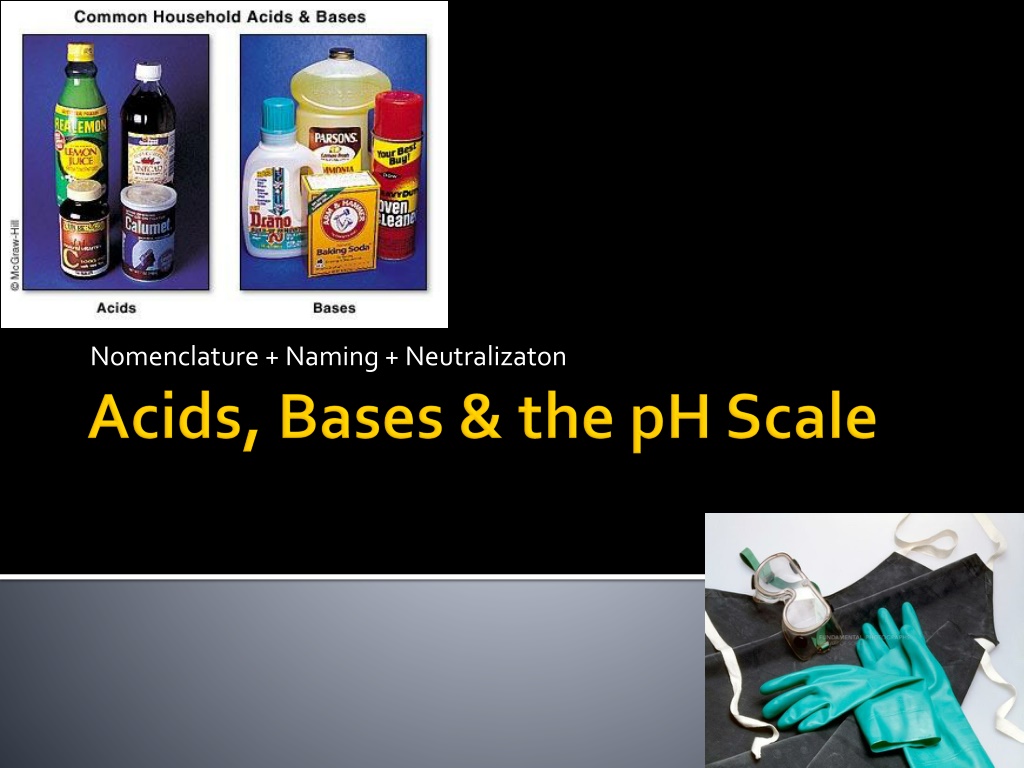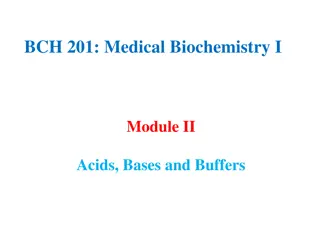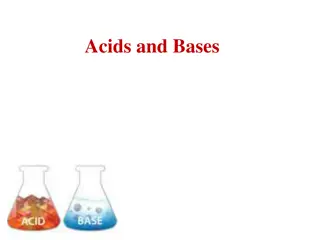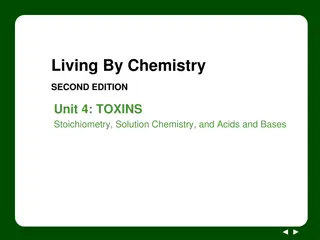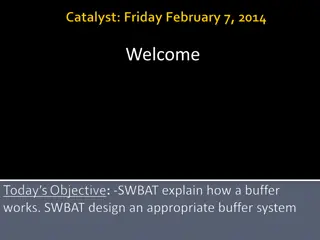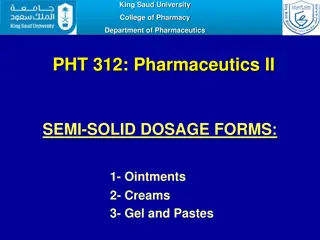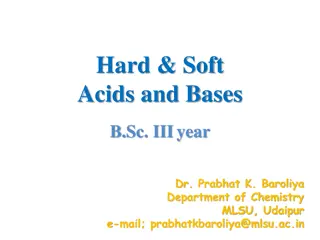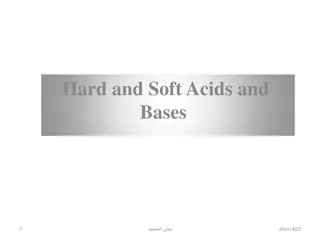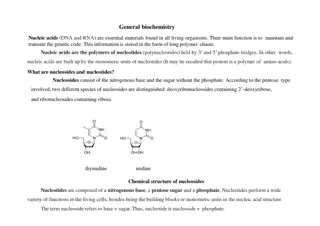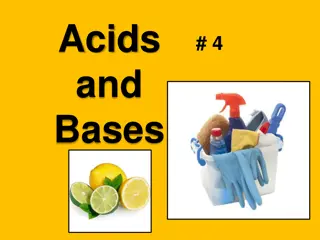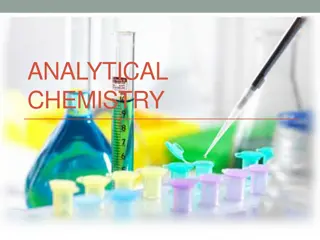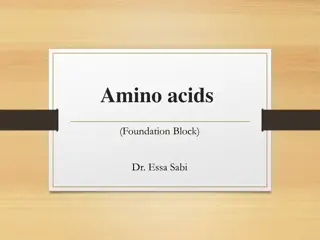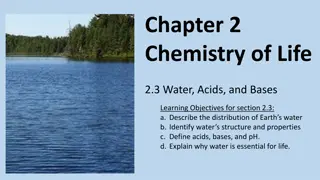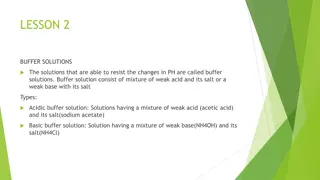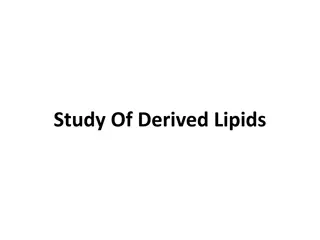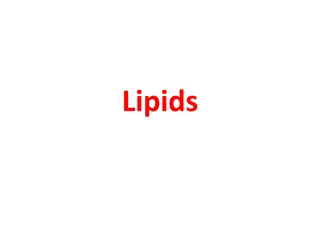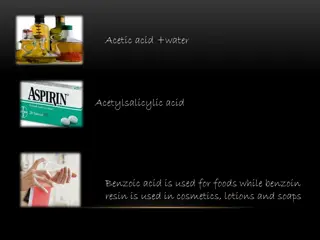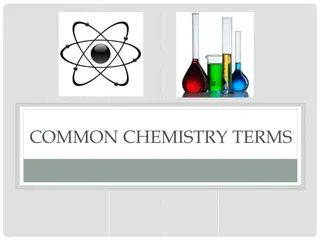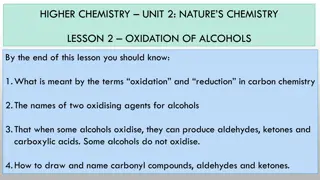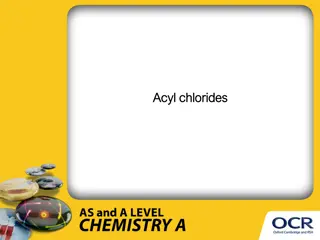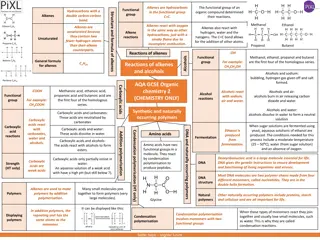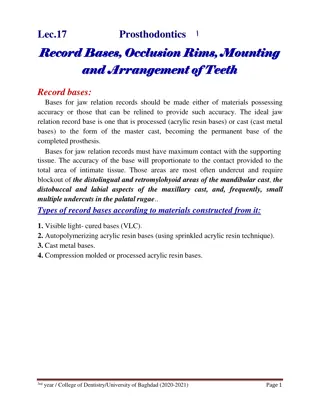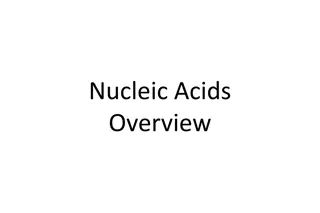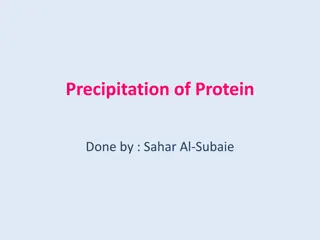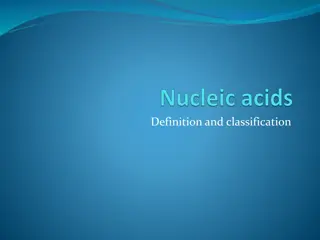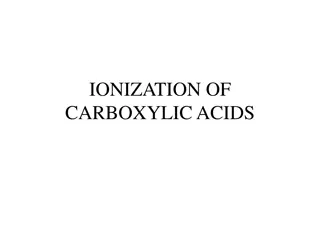Understanding Acids and Bases in Chemistry
Acids and bases play essential roles in chemistry, where they release hydrogen ions or hydroxide ions when mixed with water. Acids, like vinegar and lemon juice, are corrosive and can cause chemical burns. On the other hand, bases, such as bleach and dish soap, contain the hydroxide group in their formulas. Learn how to name acids like Hydrogen Chloride and bases like Potassium Hydroxide following specific rules. Discover the characteristics, uses, and formulas of various acids and bases in this informative guide.
Uploaded on Oct 02, 2024 | 0 Views
Download Presentation

Please find below an Image/Link to download the presentation.
The content on the website is provided AS IS for your information and personal use only. It may not be sold, licensed, or shared on other websites without obtaining consent from the author. Download presentation by click this link. If you encounter any issues during the download, it is possible that the publisher has removed the file from their server.
E N D
Presentation Transcript
These are created when substances are mixed with water. Acids: Release hydrogen ions -H+ ions into water. Bases: Release hydroxide -(OH)- ions into water. BOTH substances are corrosive, meaning they can give you a chemical burn.
Acidswill have the element hydrogen (H) first in their formula. E.G. HClor H2SO4 Examples of acids at home: E.G. Vinegar, Lemon Juice, Coke or Pepsi and batteries. There are two types of acids: 1. Oxyacids: Have oxygen in their formulas. 2. Non-oxy acids: Don t have oxygen in their formulas.
1. Oxyacids: Have oxygen in their formulas. Q: What would you name H2(SO4) using the rules you know? A: Hydrogen Sulphate Rules for naming this acid: Drop hydrogen from the name ate ending ic acid ite ending ous acids What would the name of this acid H2(SO4) be? Sulphuric Acid
2. Non-oxy acids: Dont have oxygen in their formulas. Q: What would you name HCl using the rules you know? A: Hydrogen Chloride Rules for naming this acid: Hydrogen Hydro ide ending ic acid What would the name of this acid HCl be? Hydrochloric Acid
This is the same as before we use the X- over rule . What would the formula be for Hydrophosphoric acid? First write down the chemical symbols for each element or poly. ion + their charge: H+ P3- X-Over the charges to get the formula: H3P
Sour tasting Stings to touch Corrosive Water soluble React with metals Conduct electricity
Fruit, drinks (coke, juice), yogurt, vinegar Batteries Catalyst Sore muscles
Bases will have the hydroxide (OH-) group second in their formula. E.G. K(OH) or Na(OH) Examples of bases at home: E.G. Bleach, Dishsoap, Antacid tablets, Gaviscon or Draincleaner
The rules for naming bases is the same as before: The metal name stays the same and so does the name of the polyatomic ion (hydroxide). What would KOH and NaOH be called? Potassium Hydroxide Sodium Hydroxide To get the formulas we use the X-Over rule . What would the formula be for Lithium Hydroxide?
Bitter to taste Slippery to touch Corrosive Water soluble Reactive Conductive
Both corrosive Acids must be added to water for diluting Bases react with protein can cause blindness!
The strength of acids and bases can be compared using a pH scale ACIDS NEUTRAL BASES More acidic More basic
In science we use the pH scale to determine if a substance is an acid, base or neutral (neither an acid or base) substance. ACIDS: Have a pH from o- 6.9 NEUTRAL: Have a pH of 7.0 BASES: Have a pH from 7.1-14
Q: Which is more acidic Apple or lemon juice? Q: Which is more basic Baking Soda or Ammonia? As you move farther away from the middle of the scale (Neutral pH=7) the substance becomes a stronger acid or base.
Q: What if the pH or formula isnt given to you, how can you tell if it s an acid, neutral or base? A: By using indicators. Indicators are substances that change colours when they contact an acid, base or neutral. We can observe the colour change of the indicator to determine if it s an acid, base or neutral.
Pop Rocks + Water with Bromothymol blue indicator. Water + Breath with Bromothymol Blue Comparing Indicators in Acid, Base + Neutral Substances
This is a chemical reaction where an acid is added to a base or vice-versa. The end product is a neutral substance EQUATION: Acid + Base Water + Salt (Ionic Compound) Q: What would you add (acid, base or nothing) to neutralize the pH? A. pH= 2 B. pH=9 C. pH=7
Q: What would you add (acid, base or nothing) to neutralize the pH? A. pH= 2 B. pH=9 A: A. Base B. Acid C. pH=7 C. Nothing DEMO: Water + Acid or Base with Universal Indicator
